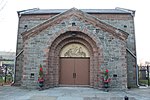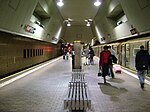Jamaica is a neighborhood in the New York City borough of Queens. It is mainly composed of a large commercial and retail area, though part of the neighborhood is also residential. Jamaica is bordered by Hollis to the east; St. Albans, Springfield Gardens, Rochdale Village to the southeast; South Jamaica to the south; Richmond Hill and South Ozone Park to the west; Briarwood to the northwest; and Kew Gardens Hills, Jamaica Hills, and Jamaica Estates to the north.
Jamaica, originally a designation for an area greater than the current neighborhood, was settled under Dutch rule in 1656. It was originally called Rustdorp before it took its current name. Subsequently, under English rule Jamaica became the center of the "Town of Jamaica". It was the first county seat of Queens County, holding that title from 1683 to 1788, and was also the first incorporated village on Long Island. When Queens was incorporated into the City of Greater New York in 1898, both the Town of Jamaica and the Village of Jamaica were dissolved, but the neighborhood of Jamaica regained its role as county seat. Today, some locals group Jamaica's surrounding neighborhoods into an unofficial Greater Jamaica area encompassing most or all of the extent of the former town.Jamaica is the location of several government buildings such as Queens Civil Court, the civil branch of the Queens County Supreme Court, the Queens County Family Court and the Joseph P. Addabbo Federal Building, home to the Social Security Administration's Northeastern Program Service Center. The U.S. Food and Drug Administration's Northeast Regional Laboratory as well as the New York District Office are also located in Jamaica. Jamaica Center, the area around Jamaica Avenue, is a major commercial center. The New York Racing Association, based at Aqueduct Racetrack in South Ozone Park, lists its official address as Jamaica (Central Jamaica once housed NYRA's Jamaica Racetrack, now the massive Rochdale Village housing development). John F. Kennedy International Airport and the hotels nearby are also located in Jamaica. The neighborhood is located in Queens Community District 12. It is patrolled by the New York City Police Department's 103rd and 113th Precincts.









